-

人教版新目标初中英语九年级下册You’re supposed to shake hands教案
教学目标:1. 掌握本单元一些重点词汇的写法和用法。2. 学会自如谈论餐桌礼仪。Step 1 RevisionAsk some students to retell the customs at the table in France in the passage in 3a.Step 2 Self checkPart 1. Fill in each bland with the correct word given. Students do the exercises by themselves at first. Then check the answers. Ask the students to comprehend the sentences and help them point out uses of some words, like “arrive (at / in) sw., spend time / money on sth , spend time / money (in) doing sth.”Part 2. Read about Fan Ling’s experience in a western restaurant. Understand the passage. Point out some key points in the passage.1. be / get used to doing sth. 习惯做某事2. begin with = start with 以….开头3. crowd v. 挤满,塞满 the crowd 人群 crowded adj. 拥挤的Then students discuss about how she would solve her problem. Ask some to share their stories with others.Part 3. Complete the crossword by looking at the sentences on the left. Then check the answers.
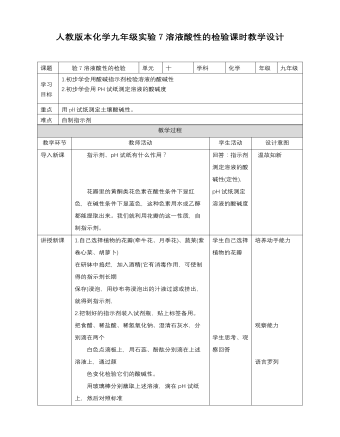
初中化学人教版九年级下册《实验活动7溶液酸碱性的检验》教案
1.自己选择植物的花瓣(牵牛花、月季花)、蔬菜(紫卷心菜、胡萝卜) 在研钵中捣烂,加入酒精(它有消毒作用,可使制得的指示剂长期 保存)浸泡,用纱布将浸泡出的汁液过滤或挤出,就得到指示剂, 2.把制好的指示剂装入试剂瓶,贴上标签备用。 把食醋、稀盐酸、稀氢氧化钠、澄清石灰水,分别滴在两个 白色点滴板上,用石蕊、酚酞分别滴在上述溶液上,通过颜 色变化检验它们的酸碱性。 用玻璃棒分别蘸取上述溶液,滴在pH试纸上,然后对照标准 比色卡比较,得出pH值,也就是酸碱度。 把上述溶液滴在白色点滴板上,用滴管吸一下你自制的指示剂,滴在滴板的溶液里,观察颜色变化,每用一种指示剂,换一下滴板的溶液。 把所得到颜色变色变化的信息和pH值数据填入教材第70页的表中。 3.取少量土壤样品,将土壤样品与蒸馏水按1∶5的质量比在烧杯中混合, 充分搅拌后静置,用玻璃棒蘸澄清的液体,滴在pH试纸上,然后对照 标准比色卡记录读数。

人教版新目标初中英语七年级下册How was your weekend教案2篇
Teaching Goal:1. General aims:Talk about recent past events2. Particular aims:A. Language Focus.Talk about recent past events and think of the past events.B. Language goalsHow was….?It was …What did …do over the weekend?C. Language structures:(1). How was your weekend? I was great. Pay attention to no form.(2). What did you do over the weekend? I played soccer. We went to the beach.D. Useful words and phrases:Words: was, did, went, beach, over, project, test, wasn’t, false, number, geography, spend, week, most, mixture, their, had, little, cook, read, saw, change, everyone, sit, sat, no, anythingPhrases: did one’s homework, played soccer, cleaned my room, went to the beach, played tennis, went to the movies, on Saturday morning, over the weekend, cook … for, what about, do some reading, have a party, talk show, go shoppingE. Grammar language:Present simple past tenseRegular and irregular verbsF. Learning strategies:Tour and holidaysG. Interdiscipinary:H. Emotion and manner:Teaching time: 5 periodsTeaching procedures:Period One教学步骤、时间 教师活动 学生活动 媒体应用Step 1Free talk 3’ Ask some questions like:Who’s on duty today?What’s the weather like? Answer and talk about something.让同学们回答下列问题1. Do you like weekend? (Let some students answer)It takes them three minutes to talk about the question.2. Why do you like weekend? (let the students answer) Most of the students like the weekend此时教师用汉语问:“在周末期间问你干了什么?这句话用英语这么回答?Let the students guess.At last the teacher give them right answer3. What did you do over the weekend?(板书、学习)

人教版新目标初中英语七年级下册What does he look like教案3篇
所需要用到的句子:Who is that?That is Jack. I like him.Why do you like him?I like him because he is interesting.Task 4: 设计理想中的人类Step one: 设计理想中的人类的外貌。把全班同学分成若干小组,学生可以边说边在纸上画出他们的模样。Step two: 设计理想中人类的性格。学生们可以把那些能描述性格的单词写在图画的旁边。Step three: 每组选出一名同学,其他同组同学提问,他作简单回答,并说明原因。所需用到的句子:What does he or she look like?He or she ...What is he or she like?He or she is ...Why?Because ...Task 5: 挑战性活动调查性格是天生的还是后天形成的,让每个同学回家去调查一下自己成长过程中性格是否有变化,具体是怎样的,为什么会这样? Teaching Aims:1. Enable students to have a general understanding of how to talk about people's physical appearance.2. Enable students to tackle some essential vocabularies and patterns about describing people. Provide them with necessary skills and methods.3. Create various chances for students to describe the persons they're familiar with, such as classmates, family members, teachers, idols, etc.

人教版新目标初中英语七年级下册Where is your pen pal from教案
2.1Match the country with the language.Step II Reading3a? let the students read the letter fast and answer the questions.? Let the students ask more questions about the letter as possible as the can.Step III Writing3b.Step IV. Pairwork2cStep V Listening2a, 2bStep V. HomeworkExercises book(1) P3Exercises book (2) P3Period FourStep I . Dictate the words and sentences in Unit1.Step II. Self-checkStep III. Check the answers for Exercises book in the unit.Step IV. Home workRevise and preparation for unit 2.教学反思:通过本单元的学习,学生基本可以谈论人们的国籍,居住城市及其所说的语言,通过书信方式去介绍自己并寻找笔友。但在涉及到国外的一些城市时,学生对这方面的知识相对欠缺,能介绍的城市并不多,也反应出学生课前预习不充分,这跟学生学习条件也有关,大多数学生无法通过网络获取所需信息。因此,在以后的教学中要多指导学生通过计算机网络获取信息,拓宽知识面。

人教版新目标初中英语八年级下册Have you ever been to an amusement park教案
(1)Have you ever been to …? Yes, I have. / Yes, I have ever been to …No, I haven’t. / No, I have never been to …(2)When did you go there? I went there last year. (3)I have never been to a water park. Neither have I. I have ever been to an amusement park. So have I. (4)How long have you been studying English? I’ve been studying English since nine o’clock. I’ve been studying English since I came back home. I’ve been studying English for five hours. (5)What’s that? It’s an amusement park in Japan. I’ve never been to an amusement park like it before. It’s fun to learn another language. Let’s go tonight. Isn’t this great?space museum, amusement park, water park, South America, Peru, Holland, European culture, tour guide, flight attendant, musical instrument, more than, be from, get to, take lessons, neither, discover, graduate, change

人教版新目标初中英语八年级下册What should I do教案2篇
说明:在帮Li Lei提建议的同时,教育学生如何学好英语。第三课时教学目标1. 语言目标:a) 词汇: Original, in style, haircut, the same as.b) 语言结构:My friend wears the same clothes and has the same haircut as I do.2. 能力目标:大多数学生能够谈论自己喜欢哪种服装,提高查找信息的能力。3. 情感目标:学会如何与朋友相处,要有自己对时尚的看法。教学重点掌握一些重要词汇。教学难点学会谈论问题,并能提出书面建议。◆教学突破首先针对Erin的问题,提出个人的建议,模仿2c部分的对话展开双人交际Pair-work;听老师诵读3a部分的信件,并找出LEFT OUT的问题所在;学生完成3b部分的内容,给Left Out提出书面的建议;学以口头形式提出自己目前存在的某个问题,讲给大家听,让同学们给自己提出一个建议,并作笔录;学生两、三个人分成一组,随意性地进行口语交际,谈论P14的第4部分的某个问题,相互交换意见。

人教版新目标初中英语八年级下册If you go to the party, you’ll have a great time教案2篇
区分宾语从句、定于从句和状语从句宾语从句和状语从句,都叫做主从复合句。宾语从句主要是中考必考的,是初中阶段必掌握的从句,宾语从句主要是掌握三要素,所谓宾语从句,就是宾语在主从复合句当中充当宾语的一个句子,叫做宾语从句。主句的谓语动词是及物动词,后面如果是词或者是短语的话,是简单句,如果是句子的话,肯定是宾语从句。I know that he good at English.就是宾语从句,三要素,一要素是要注意连词,连词一共学了三类连词,一类连词是that口语当中可以省略,就像刚才说的那一句,I hear he is good at English.还有疑问代词、疑问副词,how where when,疑问代词、疑问副词。还有一类连词weather是否的意思,不是状语从句当中的如果,这一定要和如果区分开,这是是否。I don't know if he interested at English。宾语从句要注意if是连词。第二要素是语序,要用陈述举语序。比如说你家有几口人,我们都说How many people are there in you family?但是这是简单句,一旦说成宾语从句,你可以告诉我你家有几口人吗?Could you tell me how many people there are in you family ?

人教版新目标初中英语八年级下册He said I was hard-working教案2篇
This activity introduces some new vocabulary and provide oral practice using the target language.Task 1 . Ask four students to stand in front of the class, and the teacher asks them the following questions as a reporter.1.What are you going to do when you grow up?2.What are you going to do next week?3.What are going to do after school?The students will give different answers, then ask a good student to report what they said.I am going to e a doctor.What did she say?----------She said she was going to be a doctor.I am going to have a party on Friday night.What did he say?-------He said he was going to have a party on Friday night.I am going to do my homework.What did she say ?------ She said she was going to do her homework.I am going home after school.What did she say?-----She said she was going home after school.Say In this unit we are going to learn to use words like to report what someone said.Task 2. Read the instructions. Then ask a student to read the four questions. And write the words on the Bb. Explain what soap opera is.Task 3. Ask the students to Look at the pictures, point out the TV screens in the picture. Ask one girl to read what Marcia said.What did Marcia say? She said She said she was having a surprise party for Lana on Friday night. Repeat the other pictures in the same way.Activity3. Listen and number the pictures in activity 1a.

人教版新目标初中英语八年级下册Would you mind turning down the music教案
Step 4. Group work (4)1. Ask a pair of students to read the dialogue. Say, This activity provides speaking, listening and writing practice using the target language.2. Ask students to complete the work in groups.3. Check the answers with the whole class. 4. Explain some of the language points. Step 5. Word review (Self check 1)1. Ask students to read the words and the phrases given. 2. Fill in the blanks with proper forms of these words to complete the sentences. 3. Check the answers with the whole class. Homework:Do activity 2 on page 57 after class. Period 6Teaching aims: 1. Teach vocabulary words and the useful expressions. 2. Enable the students to learn etiquette in different culture. 3. Help the students learn how to behave politely in public places and in daily life. Teaching procedures:Step 1. RevisionHelp students to review the function of making requests through a free talk. Then lead them to the topic of etiquette. Explain the meaning of etiquette. Or, ask students to look it up in the dictionary. Step 2. Pre-reading (Section 1)1. Ask students to read the picture and make a list with their partner about how many rules of etiquette can be seen being broken.

人教版新目标初中英语九年级下册By the time I got outside, the bus had already left教案
Ⅰ. Teaching Aims and Demands1. Knowledge Objects(1) Key Vocabularyoversleep(2) Target LanguageWhat happened?I overslept. And by the time I got up, my brother had already gotten in the shower.2. Ability Objects(1) Teach the students to use the new words.(2) Train the students to narrate past events with the Past Perfect Tense.(3) Train the students' listening and speaking skills with the target language.3. Moral ObjectIt’s a good habit to go to bed early in the evening and get up early in the morning. So you’ll never be in a hurry in the morning.Ⅱ. Teaching Key Points1. Key Vocabularyoversleep2. Target LanguageNarrate past events with the Past Perfect TenseⅢ. Teaching Difficult Points1. Train the students to narrate past events with the Past Perfect Tense.2. Train the students to understand the target language in spoken conversation.Ⅳ. Teaching Methods1. Thinking of examples from the students' real lives.2. Making sentences by looking at the pictures.Ⅴ. Teaching AidA tape recorderⅥ. Teaching ProceduresStep I Revision1. Revise the language points in Unit 8.Ask some questions like this: What volunteer work would you like to do?Help the students to answer, I’d like to…/I love to…/I hope to2. Practice the dialogue in Activity 3c on page 62 again. Get students to role play the similar dialogues with the following.

初中数学浙教版七年级下册《第二章 二元一次方程组 三元一次方程组及其解法》教材教案
知识与技能目标:1. 能正确说出三元一次方程(组)及其解的概念,能正确判别一组数是否是三元一次方程(组)的解;2. 会根据实际问题列出简单的三元一次方程或三元一次方程组。过程与方法目标:1. 通过加深对概念的理解,提高对“元”和“次”的认识。2. 能够逐步培养类比分析和归纳概括的能力,了解辩证统一的思想。情感态度与价值观目标:通过对实际问题的分析,使学生进一步体会方程是刻画现实世界的有效数学模型,培养学生良好的数学应用意识。
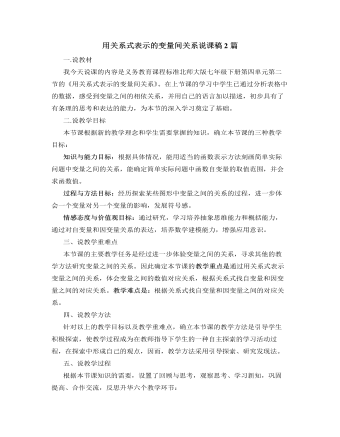
北师大版初中七年级数学下册用关系式表示的变量间关系说课稿2篇
一.说教材我今天说课的内容是义务教育课程标准北师大版七年级下册第四单元第二节的《用关系式表示的变量间关系》。在上节课的学习中学生已通过分析表格中的数据,感受到变量之间的相依关系,并用自己的语言加以描述,初步具有了有条理的思考和表达的能力,为本节的深入学习奠定了基础。二.说教学目标本节课根据新的教学理念和学生需要掌握的知识,确立本节课的三种教学目标:知识与能力目标:根据具体情况,能用适当的函数表示方法刻画简单实际问题中变量之间的关系,能确定简单实际问题中函数自变量的取值范围,并会求函数值。过程与方法目标:经历探索某些图形中变量之间的关系的过程,进一步体会一个变量对另一个变量的影响,发展符号感。情感态度与价值观目标:通过研究,学习培养抽象思维能力和概括能力,通过对自变量和因变量关系的表达,培养数学建模能力,增强应用意识。
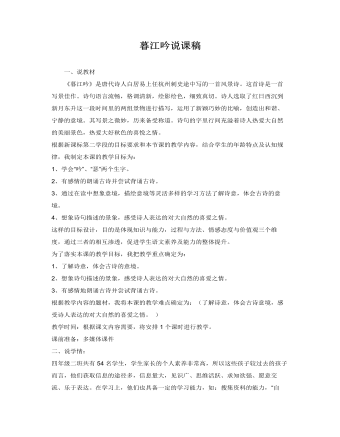
(新)部编人教版四年级上册《古诗三首》(一)说课稿(二)
一、说教材:对于《题西林壁》这篇课文,我是这样解读的:《题西林壁》是一首哲理诗,作者通过描写游览庐山的经历,总结出观察问题应客观全面,如果主观片面,就得不出正确的结论的道理。二、说学情:对于学生的情况,我是这样认为的:四年级的学生,他们的思维以具象思维为主,因此他们对于文中描写的景物有自己的感触。但是他们抽象思维能力较弱,而本诗又是一首哲理诗,学生在理解上有一定的难度,这就需要教师加以引导。除此之外,学生的有意注意力和稳定性还是较差的,所以教师在教学过程中要运用多媒体、图片等来增强教学的直观性、形象性,以吸引学生的注意力。

(新)部编人教版四年级上册《为中华之崛起而读书》说课稿(一)
1.初步探究,找切入点:我抛出问题:周恩来为什么会立下“为中华之崛起而读书”这一志向?文中的哪个词最能体现?这个词在文中出现几次?通过多个问题的设置,培养学生的理解能力,学生通过自己读课文,很快就能找出本文的关键词“中华不振”,在文中出现2次,进而引导学生划出句子。 2.比较阅读,交流发现:让生反复阅读两个句子,比较两处出现的“中华不振”有什么不同,然后在班上交流自己的发现,通过仔细比较阅读会发现:第一次的“中华不振”是由伯父告诉周恩来的,第二次的“中华不振”是由周恩来自己亲身体会到的。这一环节的设置,进一步激发学生的探索意识,让学生学会在阅读中进行比较分析,进一步的理解内容,体验情感。3.默读课文,交流感受:新课程标准指出:要让三四年级学生学会默读,做到不出声,不指读。通过让生默读课文,边读边感受:文中的哪些句子能让你感受到“中华不振”?划出相关句子,然后在班上交流感受,通过交流,有的同学会说:我从伯父的话语中能感受,有的会说:从妇女的哭诉中感受【这一环节的设置,通过让生读课文,找句子,谈感受,加深对“中华不振”的理解,更深入的体会当时周恩来的心情,理解周恩来立下志向的原因。
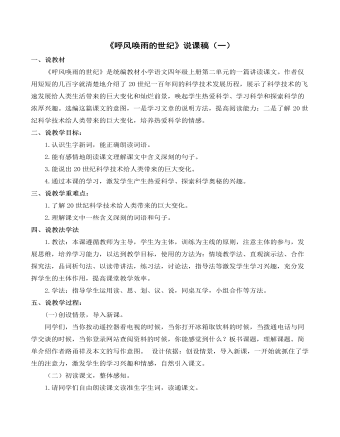
(新)部编人教版四年级上册《呼风唤雨的世纪》说课稿(一)
四、说教法学法 1.教法:本课遵循教师为主导,学生为主体,训练为主线的原则,注意主体的参与,发展思维,培养学习能力,以达到教学目标,使用的方法为:情境教学法、直观演示法、合作探究法,品词析句法、以读带讲法,练习法,讨论法,指导法等激发学生学习兴趣,充分发挥学生的主体作用,提高课堂教学效率。 2.学法:指导学生运用读、思、划、议、说,同桌互学,小组合作等方法。五、说教学过程:(一)创设情景,导入新课。 同学们,当你按动遥控器看电视的时候,当你打开冰箱取饮料的时候,当拨通电话与同学交谈的时候,当你登录网站查阅资料的时候,你能感觉到什么?板书课题,理解课题。简单介绍作者路甬祥及本文的写作意图。 设计依据:创设情景,导入新课,一开始就抓住了学生的注意力,激发学生的学习兴趣和情感,自然引入课文。
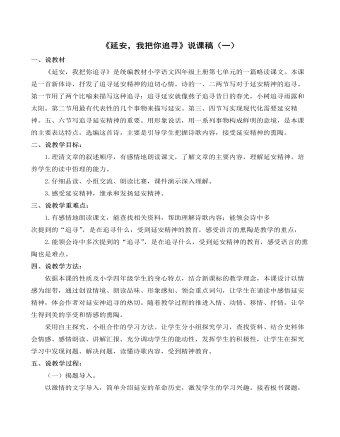
(新)部编人教版四年级上册《延安,我把你追寻》说课稿(一)
四、说教学方法: 依据本课的性质及小学四年级学生的身心特点,结合新课标的教学理念,本课设计以情感为纽带,通过创设情境、朗读品味、形象感知、领会重点词句,让学生在诵读中感悟延安精神,体会作者对延安神追寻的热切。随着教学过程的推进入情、动情、移情、抒情,让学生得到美的享受和情感的熏陶。 采用自主探究、小组合作的学习方法。让学生分小组探究学习,查找资料、结合史料体会情感、感情朗读、讲解汇报。充分调动学生的能动性,发挥学生的积极性,让学生在探究学习中发现问题、解决问题,读懂诗歌内容,受到精神教育。五、说教学过程:(一)揭题导入。 以激情的文字导入,简单介绍延安的革命历史,激发学生的学习兴趣。接着板书课题,让学生读题质疑。以三个问题:为什么追寻?追寻什么?怎样追寻?提挈全文,初步建立诗歌的层次。 学生交流对延安的了解,补充简介延安,让学生加深对延安革命圣地的感受。
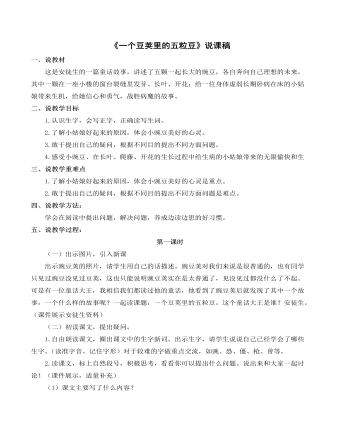
(新)部编人教版四年级上册《一个豆荚里的五粒豆》说课稿
一、说教材 这是安徒生的一篇童话故事,讲述了五颗一起长大的豌豆,各自奔向自己理想的未来,其中一颗在一座小楼的窗台裂缝里发芽、长叶、开花;给一位身体虚弱长期卧病在床的小姑娘带来生机,给她信心和勇气,战胜病魔的故事。二、说教学目标 1.认识生字,会写正字,正确读写生词。 2.了解小姑娘好起来的原因,体会小豌豆美好的心灵。3.敢于提出自己的疑问,根据不同目的提出不同方面问题。 4.感受小豌豆、在长叶、爬藤、开花的生长过程中给生病的小姑娘带来的无限愉快和生三、说教学重难点1.了解小姑娘好起来的原因,体会小豌豆美好的心灵是重点。2.敢于提出自己的疑问,根据不同目的提出不同方面问题是难点。四、说教学方法: 学会在阅读中提出问题,解决问题,养成边读边思的好习惯。
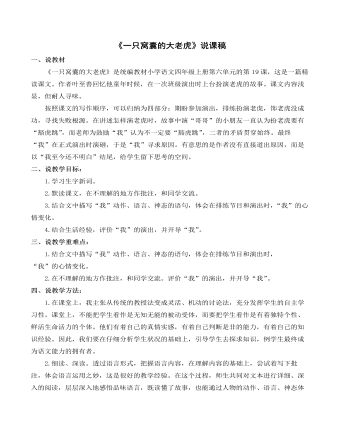
(新)部编人教版四年级上册《一只窝囊的大老虎》说课稿
一、说教材 《一只窝囊的大老虎》是统编教材小学语文四年级上册第六单元的第19课,这是一篇精读课文。作者叶至善回忆他童年时候,在一次班级演出时上台扮演老虎的故事。课文内容浅显,但耐人寻味。按照课文的写作顺序,可以归纳为四部分:期盼参加演出,排练扮演老虎,饰老虎没成功,寻找失败根源。在讲述怎样演老虎时,故事中演“哥哥”的小朋友一直认为扮老虎要有“豁虎跳”,而老师为鼓励“我”认为不一定要“豁虎跳”,二者的矛盾贯穿始终。最终“我”在正式演出时演砸,于是“我”寻求原因。有意思的是作者没有直接道出原因,而是以“我至今还不明白”结尾,给学生留下思考的空间。二、说教学目标: 1.学习生字新词。2.默读课文,在不理解的地方作批注,和同学交流。
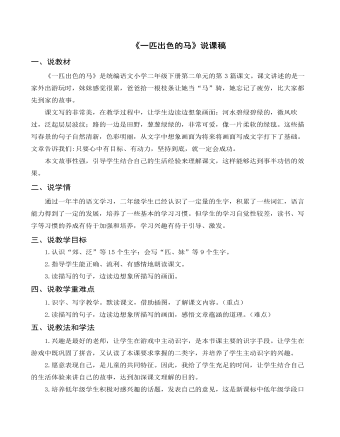
(说课稿)《一匹出色的马》部编人教版二年级上册语文
一、说教材《一匹出色的马》是统编语文小学二年级下册第二单元的第3篇课文。课文讲述的是一家外出游玩时,妹妹感觉很累,爸爸拾一根枝条让她当“马”骑,她忘记了疲劳,比大家都先到家的故事。 课文写的非常美,在教学过程中,让学生边读边想象画面:河水碧绿碧绿的,微风吹过,泛起层层波纹;路的一边是田野,葱葱绿绿的,非常可爱,像一片柔软的绿毯。这些描写春景的句子自然清新,色彩明丽,从文字中想象画面为将来将画面写成文字打下了基础。文章告诉我们:只要心中有目标、有动力,坚持到底,就一定会成功。 本文故事性强,引导学生结合自己的生活经验来理解课文,这样能够达到事半功倍的效果。二、说学情通过一年半的语文学习,二年级学生已经认识了一定量的生字,积累了一些词汇,语言能力得到了一定的发展,培养了一些基本的学习习惯。但学生的学习自觉性较差,读书、写字等习惯的养成有待于加强和培养,学习兴趣有待于引导、激发。三、说教学目标1.认识“郊、泛”等15个生字;会写“匹、妹”等9个生字。2.指导学生能正确、流利、有感情地朗读课文。3.读描写的句子,边读边想象所描写的画面。

